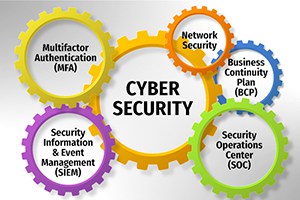In the fast-evolving landscape of cybersecurity, understanding the terminology is necessary to become an informed business manager. In this blog post, we demystify some commonly used cybersecurity terms. With this information, you’ll at least have a basic understanding of what your techies are speaking.
Firewall (FW):
A network security system that monitors and controls incoming and outgoing network traffic based on predetermined security rules.
Intrusion Detection System (IDS):
A security technology that monitors and analyzes network or system activities for signs of malicious activities or security policy violations.
Virtual Private Network (VPN):
A secure network connection over the internet that allows remote users to access a private network.
Phishing:
A type of cyberattack where attackers use deceptive emails or websites to trick individuals into revealing sensitive information.
Malware:
Software designed to harm or exploit computer systems, including viruses, worms, trojan horses, ransomware, and spyware.
Two-Factor Authentication (2FA):
An authentication method that requires users to provide two different authentication factors (e.g., password and a mobile verification code).
Denial of Service (DoS) Attack:
An attack that aims to make a computer or network resource unavailable to its intended users by overwhelming it with a flood of internet traffic.
Endpoint Security:
The approach of securing end-user devices such as computers, smartphones, and tablets from cybersecurity threats.
Patch Management:
The process of managing and applying updates or patches to software systems to fix vulnerabilities and improve security.
Encryption:
The process of converting information into a code to prevent unauthorized access.
Security Information and Event Management (SIEM):
A comprehensive approach to security management that combines the capabilities of security information management (SIM) and security event management (SEM).
Access Control List (ACL):
A list of rules specifying which users or system processes are granted access to objects, as well as what operations are allowed on given objects.
Penetration Testing:
The practice of testing a computer system, network, or web application to find security vulnerabilities that an attacker could exploit.
Incident Response:
A process for managing and mitigating the aftermath of a security incident or data breach.
Security Assessment:
An evaluation of an organization’s information system to identify security vulnerabilities and assess the effectiveness of existing security measures.
Biometric Authentication:
Authentication based on unique physical or behavioral characteristics, such as fingerprints, iris scans, or voice recognition.
Security Policy:
A set of rules and practices that specify or regulate how an organization manages, protects, and distributes sensitive information.
Zero-Day Exploit:
An attack that targets a software vulnerability on the same day it becomes publicly known, before the software vendor releases a patch.
Data Loss Prevention (DLP):
A strategy for preventing the unauthorized access, use, or distribution of sensitive data.
Network Segmentation:
The practice of dividing a computer network into subnetworks to improve performance, security, and manageability.
Cryptography:
The practice and study of techniques for securing communication and data from third parties.
Honeypot:
A decoy system or network designed to attract and detect attackers and study their behavior.
Single Sign-On (SSO):
A session/user authentication process that enables a user to enter one set of login credentials to access multiple applications.
SSL/TLS (Secure Sockets Layer/Transport Layer Security):
Protocols that provide secure communication over a computer network by encrypting the data.
Security Token:
A physical or virtual device that provides an additional layer of user authentication.
Social Engineering:
The manipulation of individuals to disclose confidential information or perform actions that may compromise security.
Antivirus Software:
Software designed to detect, prevent, and remove malicious software (malware) from computer systems.
Risk Assessment:
The process of identifying, analyzing, and evaluating potential risks to an organization’s assets.
Multi-factor Authentication (MFA):
An authentication method that requires users to provide more than one form of identification.
Threat Intelligence:
Information that is collected, analyzed, and used to anticipate and prevent cybersecurity threats.
Are you looking for IT Security help for your organization? We’d love to help. Give us a call at 410.543.8200 today!

